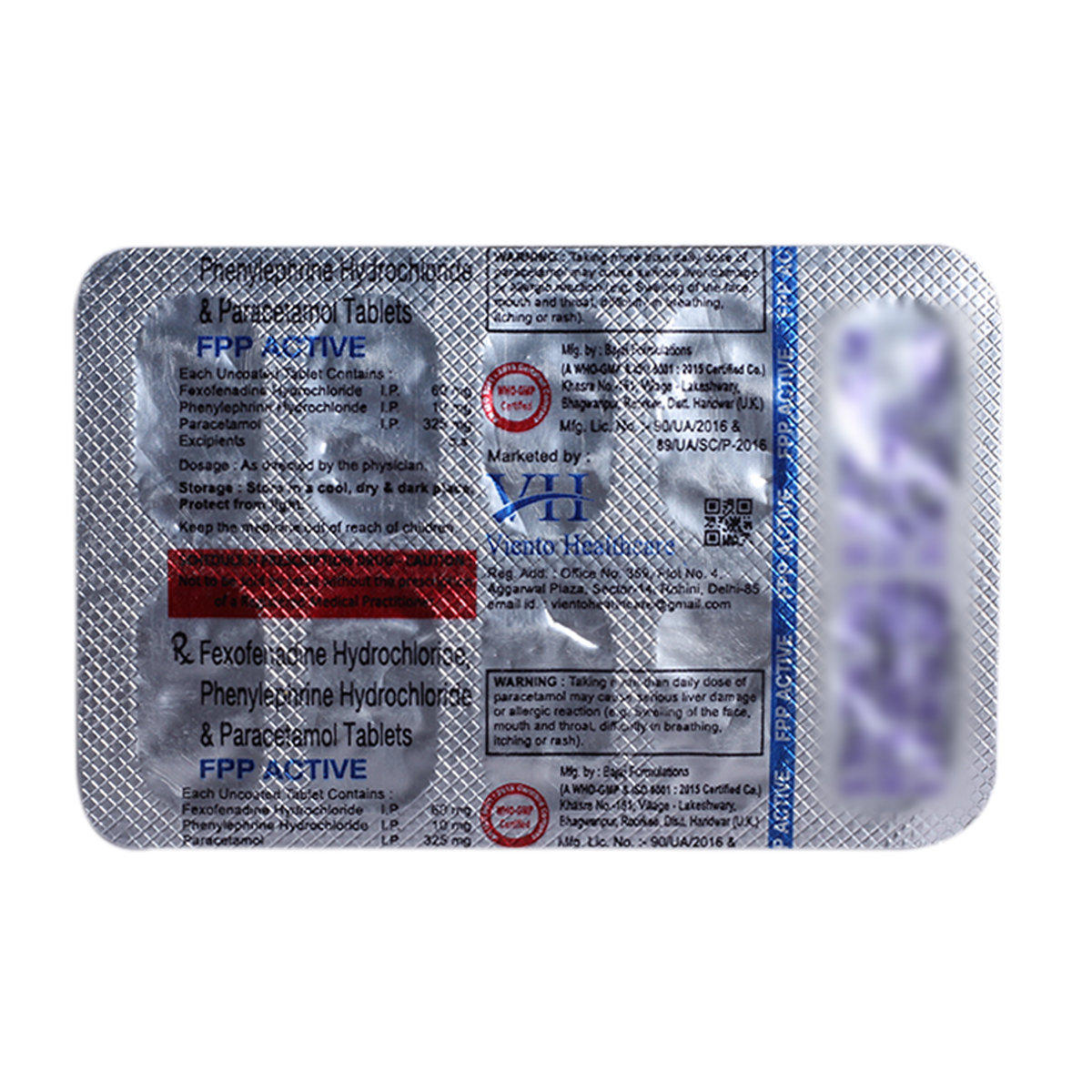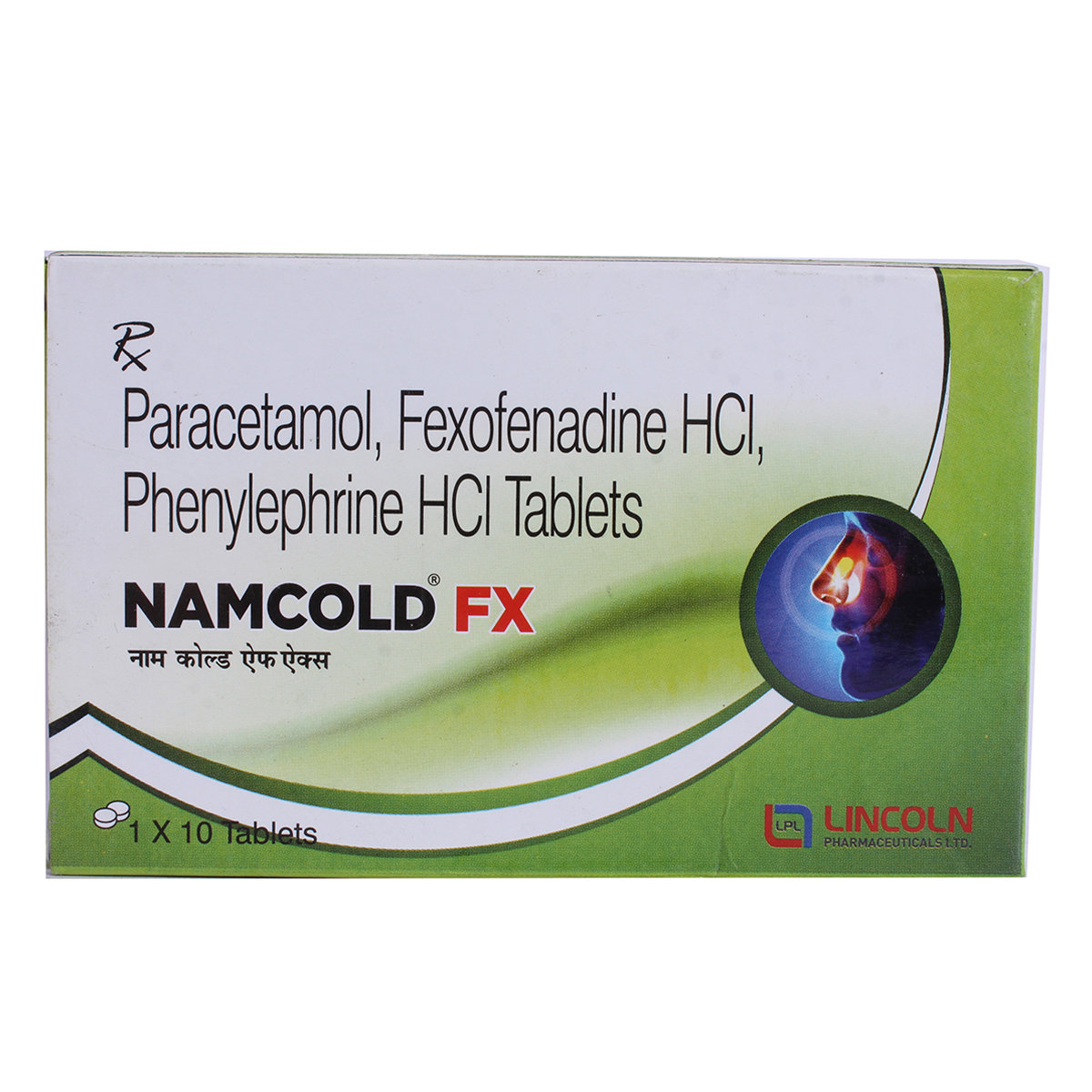Fexofenadine+paracetamol+phenylephrine
About Fexofenadine+paracetamol+phenylephrine
Fexofenadine+paracetamol+phenylephrine belongs to the class of medications called ‘cough and cold preparations’ used in the treatment of the common cold and allergic symptoms such as the runny nose, sneezing, itchy or watery eyes and blocked nose. The common cold is a respiratory illness of the nose and throat caused by ‘rhinoviruses’. Allergies are immune system reactions to foreign bodies or allergens such as certain foods, chemicals, pet dander, or pollen.
Fexofenadine+paracetamol+phenylephrine contains Fexofenadine, Paracetamol, and Phenylephrine. Fexofenadine is an antiallergic medicine. It blocks the release of histamine, chemical substances that cause allergic symptoms such as the runny nose, watery eyes, itching, sneezing, and swelling or congestion. Paracetamol is an analgesic (reduce pain) and antipyretic (reduce fever). It can block the production of prostaglandins (chemical substances), thereby decreasing pain, swelling, and inflammation. Phenylephrine is a decongestant that can reduce swelling in the nasal passages making it easy to breathe.
You should take this medicine exactly as prescribed by the doctor. The common side-effects of Fexofenadine+paracetamol+phenylephrine are nausea, vomiting, headache, ear pain, trouble sleeping, restlessness, and palpitations (pounding heart). These side-effects usually go away without requiring any medical attention. However, if any of these side-effects persist or get worse, inform your doctor immediately.
It is not recommended to take Fexofenadine+paracetamol+phenylephrine if you are allergic to any contents of it. It should not be used in patients with severe liver failure. It should be used with caution in children, patients with liver or kidney disease, pregnant women, breastfeeding mothers, and elderly people. Alcohol increases the risk of side-effects. Fexofenadine+paracetamol+phenylephrine may decrease alertness, so do not drive or operate heavy machinery if you are not fully alert.
Uses of Fexofenadine+paracetamol+phenylephrine
Medicinal Benefits
Fexofenadine+paracetamol+phenylephrine is composed of three medicines, namely Fexofenadine, Paracetamol, and Phenylephrine. Fexofenadine is an anti-allergic drug that works by blocking the action of histamine, a substance responsible for causing allergic reactions. It helps relieve allergy symptoms such as sneezing, running nose, watery eyes, itching, swelling, congestion or stiffness. Paracetamol is an analgesic (relieves pain) and antipyretic (reduces fever) that works by inhibiting the production of certain chemical messengers in the brain known as 'prostaglandin's responsible for pain and fever. Phenylephrine helps in shrinking the blood vessels in the nostrils and the nasal passage and reducing stuffy nose. Together, Fexofenadine+paracetamol+phenylephrine can effectively treat common cold and allergy symptoms.
Directions for Use
- Fexofenadine+paracetamol+phenylephrine can be taken with or without food as prescribed by your doctor.
- Follow your doctor's instructions on the dosage and timing of this medication to ensure safety.
- Swallow it as a whole with a glass of water.
- Do not chew, crush or break it.
Storage
Side Effects of Fexofenadine+paracetamol+phenylephrine
- Nausea
- Vomiting
- Headache
- Ear pain
- Trouble sleeping
- Restlessness
- Palpitations (pounding heart)
Drug Warnings
Do not take Fexofenadine+paracetamol+phenylephrine if you have been taking medicines to treat depression (monoamine oxidase inhibitors) such as selegiline and rasagiline in the past 14 days. Before taking Fexofenadine+paracetamol+phenylephrine, inform your doctor if you have any liver or kidney disease, diabetes, hyperactive thyroid, heart problems, fits, and glaucoma (increased pressure in the eye). Fexofenadine+paracetamol+phenylephrine may cause liver damage on prolonged use or when used in high doses, so it is not recommended for use in patients with severe liver failure.
Drug Interactions
Drug-Drug Interactions: Fexofenadine+paracetamol+phenylephrine may interact with medicines used to treat nausea and vomiting (domperidone and metoclopramide), antidepressants (phenelzine, procarbazine, rasagiline, selegiline, tranylcypromine, imipramine, and desipramine, etc.), anticoagulant (warfarin), a medicine used to treat high cholesterol (cholestyramine), medicines used to treat fits, anti-HIV drug (zidovudine), narcotic pain killers (codeine and morphine), antibiotic (chloramphenicol), medicines used to treat asthma (epinephrine and formoterol), antacids (magnesium hydroxide and aluminium hydroxide), and medicines used to treat high blood pressure (methyldopa and reserpine).
Drug-Food Interactions: Avoid consumption of grapefruit juice and alcohol as it may increase the risk of side-effects.
Drug-Disease Interactions: Fexofenadine+paracetamol+phenylephrine should not be used in patients with severe liver failure. It should be used with caution in patients with liver or kidney disease, diabetes, hyperactive thyroid, heart problems, fits, and glaucoma (increased pressure in the eye).
Drug-Drug Interactions Checker List:
Safety Advice

Alcohol
cautionAlcohol consumption may cause liver damage and increase the risk of side-effects.

Pregnancy
cautionFexofenadine+paracetamol+phenylephrine is a category C medicine and may cause toxic effects to the unborn baby. When clinically needed, Fexofenadine+paracetamol+phenylephrine is given to pregnant women after doing a risk/benefit assessment.

Breast Feeding
safe if prescribedFexofenadine+paracetamol+phenylephrine is probably safe when used in breastfeeding mothers.

Driving
cautionFexofenadine+paracetamol+phenylephrine may decrease alertness. So, avoid driving or operating heavy machinery while using this medicine if you are not fully alert.

Liver
cautionFexofenadine+paracetamol+phenylephrine should not be used in patients with severe liver diseases. In mild to moderate conditions, the dose may have to be adjusted by your doctor.

Kidney
unsafeFexofenadine+paracetamol+phenylephrine should be used with caution in patients with kidney diseases. The dose may have to be adjusted by your doctor.

Children
cautionFexofenadine+paracetamol+phenylephrine should be used with caution in children. The dose may have to be adjusted by your doctor based on age and medical history.
Habit Forming
Diet & Lifestyle Advise
- Staying hydrated is vital for those with a cough or cold. Drinking liquids at room temperature can alleviate cough, runny nose, and sneezing.
- The immune system is affected by stress and raises the risk of being sick. An individual can exercise regularly, meditate, do deep breathing, and try progressive muscle relaxation techniques to relieve stress.
- To stay fit and safe, try to sleep at least 8 hours each night.
- It is advised to avoid contact with known allergens (allergy-causing agents) such as pollen, dust, etc. Certain food items are known to cause allergies to you.
- Maintain personal hygiene and keep your surroundings clean.
Special Advise
- If you are undergoing an allergy test, the doctor might advise you to stop Fexofenadine+paracetamol+phenylephrine 5 days before the test as this medicine may interfere with the test results.
- Check the labels carefully before taking any over-the-counter (OTC) medicines as many pain and cold medicines contain paracetamol as an ingredient.
Patients Concern
Disease/Condition Glossary
Common cold: The common cold is an infection caused by the virus, mainly known as ‘rhinoviruses’ affecting the nose and throat (upper respiratory tract). Children younger than 6 years are at the most significant risk of colds, but healthy adults can also be affected to have 2-3 colds annually. In most cases, cold symptoms are recovered within a week or ten days. However, symptoms might last longer in people who smoke or are exposed to allergens like pollutants, dust, etc. The common cold symptoms include sneezing, sore throat, cough, congestion, mild body pains, low fever, mild headache, feeling unwell, stuffy, or runny nose. In some cases, the discharge from the nose may become thicker and yellow or green, which is not an indication of bacterial infection.
Allergies: It occurs when foreign elements that cause allergy (allergens) attack and invade our body, causing the release of histamines. This chemical messenger 'histamines' causes swelling, inflammation, redness, itchiness, itchy/watery nose, throat, and watery eyes. Allergies generally occur due to chemicals, air pollution, pet danders, dust, pollen hairs, seasonal allergies like hay fever, etc.
FAQs
Fexofenadine+paracetamol+phenylephrine is used to treat symptoms of common cold and allergy such as runny nose, sneezing, itchy or watery eyes and blocked nose.
Fexofenadine+paracetamol+phenylephrine contains Fexofenadine, Paracetamol, and Phenylephrine. Fexofenadine is an antiallergic medicine. It blocks the release of histamine, chemical substances that cause allergic symptoms such as the runny nose, watery eyes, itching, sneezing, and swelling or congestion. Paracetamol is an analgesic (reduce pain) and antipyretic (reduce fever). It can block the production of prostaglandins (chemical substances), thereby decreasing pain, swelling, and inflammation. Phenylephrine is a decongestant that can reduce swelling in the nasal passages making it easy to breathe.
Fexofenadine+paracetamol+phenylephrine should not be used if you have taken antidepressants in the last 14 days. So, it is always advised to inform your doctor about all the prescription, non-prescription, and dietary supplements you are taking, to identify any interactions with the Fexofenadine+paracetamol+phenylephrine.
Fexofenadine+paracetamol+phenylephrine should be used with caution in elderly people as there is an increased risk of side-effects. The dose may have to be adjusted by the doctor based on the health condition.
The common side-effects of Fexofenadine+paracetamol+phenylephrine are nausea, vomiting, headache, ear pain, trouble sleeping, restlessness, and palpitations (pounding heart). These side-effects are usually mild and temporary. However, if any of these side-effects persist or get worse, inform your doctor immediately.
No, there is no evidence that Fexofenadine+paracetamol+phenylephrine is habit-forming or addictive.
No, Fexofenadine+paracetamol+phenylephrine is not recommended for treating acute asthma attacks. It is generally used to treat symptoms of the common cold and allergies, such as runny nose, sneezing, and congestion.
You can take Fexofenadine+paracetamol+phenylephrine for symptoms of a cough or throat infection associated with the common cold or allergies. However, consult your doctor before taking Fexofenadine+paracetamol+phenylephrine.
You can stop taking Fexofenadine+paracetamol+phenylephrine once your allergy symptoms are relieved. Fexofenadine+paracetamol+phenylephrine is usually meant for short-term use to manage symptoms like runny nose, sneezing, and congestion. However, it is always better to take your doctor’s advice before discontinuing Fexofenadine+paracetamol+phenylephrine.
Yes, Fexofenadine+paracetamol+phenylephrine can cause dizziness as a side effect. If you experience dizziness, it's important to avoid activities that require mental alertness, such as driving or operating heavy machinery, until you know how the medication affects you.
Avoid consumption of grapefruit juice and alcohol as it may increase the risk of side-effects like dizziness.
No, taking higher doses than prescribed is not effective, and it may cause side effects. Therefore it's important to follow the dosage instructions provided by your doctor to ensure safe and effective use.
Store Fexofenadine+paracetamol+phenylephrine at a temperature not exceeding 30°C in a dry and dark place. Keep out of reach of children.






